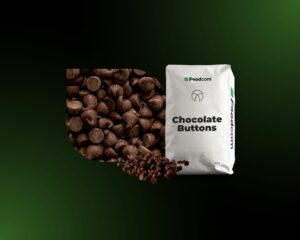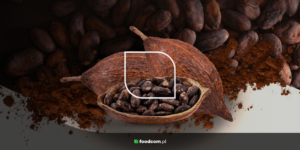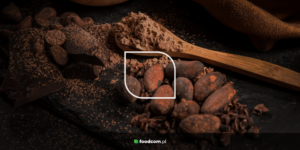- Chocolate production is a complex process involving, among other things, bean fermentation, roasting, grinding, conching, and tempering.
- The raw materials used in production come mainly from cocoa plantations in Africa, South America, and Asia.
- The components used in chocolate production include cocoa butter, cocoa powder, and cocoa mass.
- The production process may vary slightly depending on the type of chocolate.
Chocolate is the result of a precise combination of natural ingredients and advanced technology. The main raw material for its production is cocoa beans, which contain cocoa fat and aromatic substances that give chocolate its taste. The key ingredients in each chocolate recipe are:
- cocoa pulp – a dense, high-fat mass obtained from ground beans, through the separation of which cocoa butter and cocoa powder are made,
- cocoa butter – cocoa fat which gives the chocolate the desired texture and shine,
- milk powder – in the case of milk chocolate,
- additives – sugar and vanillin or natural flavourings for a characteristic flavour profile, lecithin (usually soya) – as an emulsifier to improve texture.
Depending on the proportions of these ingredients, we get milk chocolate, dark chocolate, dessert chocolate or white chocolate. Foodcom S.A., as a wholesaler of cocoa, supplies all these ingredients to chocolate production plants throughout Europe.
The stages of chocolate production
How is chocolate made? Its production is not just about combining the right ingredients. The process involves a complex sequence of technological operations which determine the final characteristics of the product.
In the first stage, the key question is: how is cocoa produced? This is because the process of chocolate production begins on the cocoa plantations, where, after the fruit is harvested, it undergoes several days of fermentation and the beans are separated from the pulp. The beans are then dried in the sun and packed for transport. In the processing plants, they are successively roasted, shelled and ground to produce pulp, butter and cocoa powder.
The actual stages of chocolate production include:
- Roasting – this occurs at a temperature of 110 to 150°C and the parameters of the process affect the flavour profile of the chocolate (longer and more intense roasting deepens the caramel, nut and earthy notes).
- Pre-crushing and shell separation – after roasting, the beans are shelled (mechanically or pneumatically) and crushed into pieces (called nibs).
- Grinding and formation of the cocoa pulp – the crushed beans go to mills where they are ground until a smooth, liquid cocoa mass containing about 50-55% fat is obtained.
- Mixing the ingredients – the cocoa mass is combined with sugar, milk powder and cocoa butter. The initial chocolate mass is still grainy.
- Refining – the chocolate mass goes to the refiners, where the particles of the ingredients are crushed to a size of less than 30 microns. This is the stage that determines the smoothness of the texture and the pleasant ‘melt-in-the-mouth’ sensation.
- Conching – this is the mixing and heating of the mass for hours in special equipment. The chocolate acquires the desired aromatic profile and loses excess moisture and volatile acids.
- Tempering – involves the controlled cooling and heating of the chocolate so that the cocoa fat crystallises in a stable form.
- Moulding and cooling – the final stage involves pouring the finished mass into moulds (slabs, bars, pralines), followed by cooling and packaging of the finished product.
Types of chocolate and the specifics of their production
Although the basic stages of production remain similar, the recipes and technological requirements, such as proportions of ingredients or conching techniques, differ depending on the type of chocolate.
Dark chocolate
Contains the highest proportion of cocoa solids – usually between 70% and 90%. Dark chocolates with a higher cocoa solids content are dark chocolates and those with a lower content (often 50-70%) are dessert chocolates. These products have no milk added and contain less sugar than other types of chocolate. They are characterised by an intense, dry taste and a high polyphenol content. In the production of dark chocolate, the conching process is particularly prolonged in order to smooth out the bitterness.
Milk chocolate
This is the most common form of chocolate in Europe. It contains approximately 25-35% cocoa (including butter and pulp) and milk (powdered or condensed). The addition of milk requires precise control of the moisture content during the production process. The presence of dairy ingredients must also be taken into account in the refining and conching processes. The flavour profile of the chocolate depends on the type and quality of milk used.
White chocolate
Does not contain cocoa pulp – it is based solely on cocoa butter, milk and sugar. It has a creamy taste, a delicate colour and a smooth texture. In its production process, particular attention must be paid to tempering, which must be extremely precise due to the fat’s sensitivity to temperature. Flavouring (e.g. with vanilla) is also crucial – the lack of intense cocoa notes requires flavouring additives.
Chocolate is not only an iconic treat, but also a complex technological product whose quality depends on many factors – from the fermentation of the beans and the quality of the ingredients to the mixing and cooling processes. It is used both as a finished product and as a semi-finished product for confectionery, bakery products, ice cream or instant meals. The high quality of the cocoa beans is crucial to its production, which is why it is worth relying on reliable suppliers such as Foodcom.










